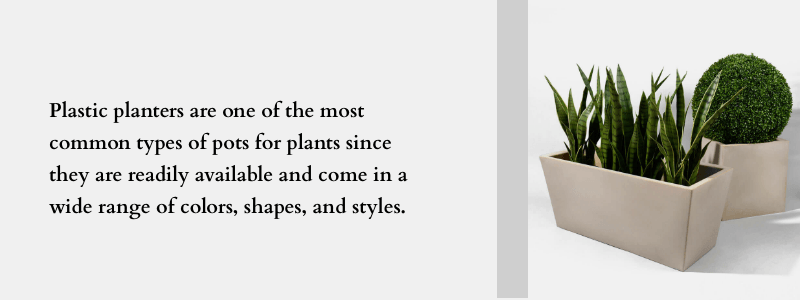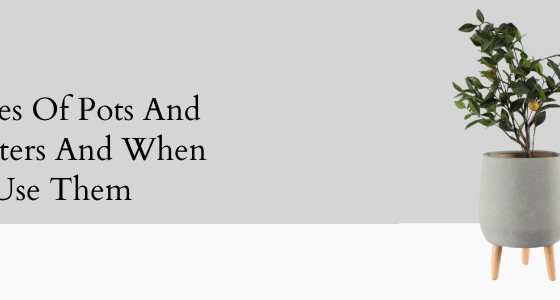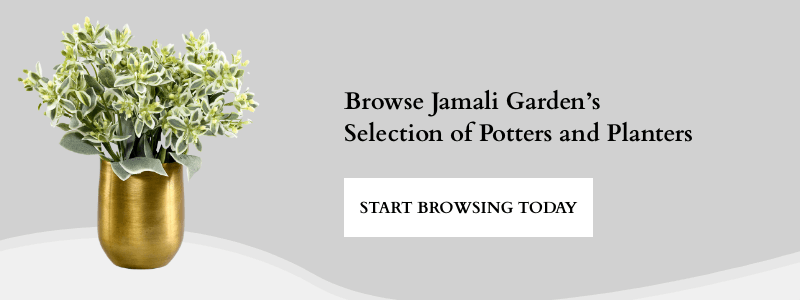Types of Pots and Planters and When to Use Them

Whether you’re trying to elevate the decor in your home or are designing a space for someone else, pots and planters can help you brighten up any room. Pots and planters are made from a wide range of materials that serve different purposes and have various benefits for plant enthusiasts. Choosing the right planter will benefit your plants’ health and elevate your space’s beauty. Some of the best planters for plants include ceramic, plastic, metal, and wood pots. Continue reading to learn more about the different types of planter pots and which to use for your garden or interior design projects.
Ceramic Planters
Ceramic planters are a popular choice among homeowners and professional gardeners. Ceramic pots are made from clay and are porous, allowing water and air to pass through, preventing root rot. As a result, these planters are best suited to indoor plants and colder environments. Ceramic planters are commonly used for indoor gardens and plants or when cold swells are common. Some of the benefits of ceramic planters include:
- Cost: Ceramic pots come in a wide range of prices, from affordable to luxurious and expensive, so you’re bound to find something within your budget.
- Water indicators: Some ceramic planters will look different depending on whether the plants have been watered enough. Ceramic pots usually appear darker when there is enough water and lighter when you need to rewater your plants.
- Protective lacquer layers: Ceramic pots have a protective layer that helps prevent the soil from drying too quickly.
- Durability: If you choose a ceramic planter that’s been glazed, it will withstand cold climates and direct sunlight longer than unglazed pots. As long as you don’t drop these pots, they can be reused for years to come.
While you can choose from a wide range of colors and styles with ceramic planters, it’s essential to note that these pots are more fragile than others. Ceramic pots can crack, chip, or break easily, so these planters must be taken care of and handled gently. These pots can also become heavy when filled with soil and plant life, so you shouldn’t move them around too often.
Plastic Planters
Plastic planters are one of the most common types of pots for plants since they are readily available and come in a wide range of colors, shapes, and styles. Plastic planters are also more durable than other types of planters since they’re unlikely to break when dropped, making them one of the best pots for outdoor plants. However, plastic can still become damaged despite its durability, so it’s essential to take proper care of these planters to ensure they last as long as possible.
There are many advantages of plastic planters, including:
- Weight: Plastic is an extremely lightweight material, meaning you won’t have any trouble getting these planters where they need to go, even when they’re loaded with heavy soil and plant life. Despite how light plastic is, it can withstand rough handling.
- Cost: Plastic is mass-produced, so it’s one of the most inexpensive materials in planters.
- Options: Plastic can be customized to meet your needs, whether you need specific colors or want the plastic planter to have a specific shape. Plastic can be molded to meet a specific design, with endless color options.
You can use plastic planters whenever you need an affordable, simple solution for your plants or garden. Plastic is an excellent option for beginners or if you ever decide to reorganize your plants. However, it’s essential to note that plastic contains toxic materials that can leech into your plants and affect the surrounding environment, making it one of the least sustainable options on the market.

Metal Planters
You can find various metal planters made from different materials, including aluminum, copper, zinc, and steel. Metal is incredibly durable, but it’s essential to use caution when using these planters outdoors. Direct sunlight can make these planters hot and dangerous to touch until they cool off. The heat generated by these planters also requires that you use a liner when planting anything since excess heat can damage plant growth.
Metal is also not a porous substance, so you’ll need to drill holes to allow water to escape. You’ll also need to watch any outdoor metal planters since rainfall and excess humidity can cause the metal to rust or change in color, affecting the appearance of your garden, interior design, or event.
Despite these challenges, metal planters have some benefits that may be suited to your applications, including:
- Strength: Metal planters are one of the most durable types on the market. You don’t need to worry about metal planters cracking or chipping, and you can usually leave metal outside for years before it shows any sign of wear.
- Appearance: Many people prefer metal planters because they make a great addition to all types of decor. Each metal has a different appearance, so you’ll likely be able to find one that suits your design style. For example, copper has a rustic look that looks good in country or farm-style homes.
- Durability: Metal pots can withstand tough weather conditions compared to other planters. You don’t need to worry about metal cracking in the cold or becoming damaged in the rain. You’ll need to look out for signs of rusting or overheating if you use metal planters outdoors instead of indoors.
Wood Planters
Wood planters are a popular and natural choice among many gardeners and interior designers. These planters have an aesthetically pleasing natural look that fits almost any style. You can choose from pine, rosewood, fir, cedar, and other popular woods for your planters. Some types of wood will be more lightweight than others, allowing you to reorganize your space after planting.
Some of the main benefits of choosing wood planters include:
- Natural materials: Wood occurs naturally, so you won’t have to worry about harmful toxic leeching into your plants or the surrounding environment. However, you need to take extra care of wood planters to prevent rot, which includes adding a protective layer to seal the wood from weathering and moisture.
- Appearance: Many people love the appearance of wood since it brings a natural, ornamental touch to a space. Wood planters are also popular at different events, such as weddings, birthdays, or other celebrations.
- Life span: Wood planters can last for years with the proper care. While other planter materials, such as fiberglass, can last longer, wood planters still have an impressive life span for a natural option.
If you’re more concerned about your plant’s health or the effect on the environment, you may choose wood planters. These pots are also suited to some interior design styles, making these planters an excellent option.
Browse Jamali Garden’s Selection of Potters and Planters
Jamali Garden has you covered if you’re looking for the best planters for your home, interior design project, or event. Our range of planters encompasses ceramic, wood, metal, and plastic options. We also offer other floral and garden supplies and plants to help you achieve your goals.
Browse our website to gain inspiration for your event or home. We have products from all across the world, so you’re bound to find something that fits your style. Start browsing today or contact us to learn more about our products.


